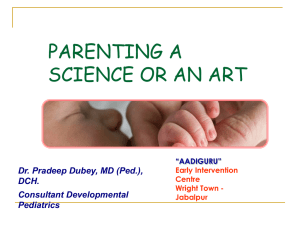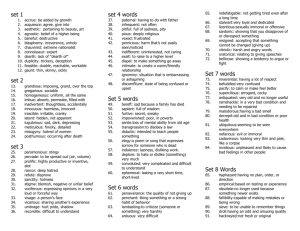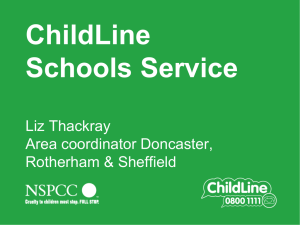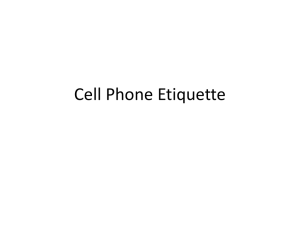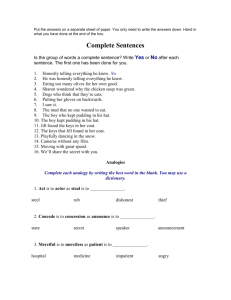Lesson Plan: Barriers to Cross
advertisement
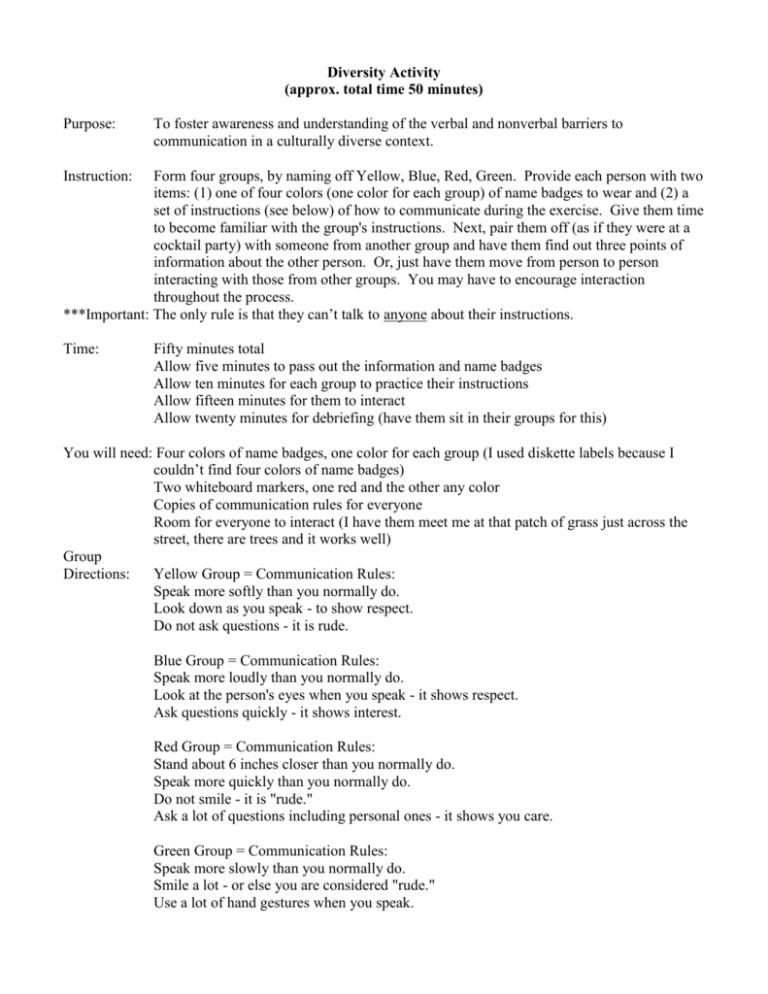
Diversity Activity (approx. total time 50 minutes) Purpose: To foster awareness and understanding of the verbal and nonverbal barriers to communication in a culturally diverse context. Instruction: Form four groups, by naming off Yellow, Blue, Red, Green. Provide each person with two items: (1) one of four colors (one color for each group) of name badges to wear and (2) a set of instructions (see below) of how to communicate during the exercise. Give them time to become familiar with the group's instructions. Next, pair them off (as if they were at a cocktail party) with someone from another group and have them find out three points of information about the other person. Or, just have them move from person to person interacting with those from other groups. You may have to encourage interaction throughout the process. ***Important: The only rule is that they can’t talk to anyone about their instructions. Time: Fifty minutes total Allow five minutes to pass out the information and name badges Allow ten minutes for each group to practice their instructions Allow fifteen minutes for them to interact Allow twenty minutes for debriefing (have them sit in their groups for this) You will need: Four colors of name badges, one color for each group (I used diskette labels because I couldn’t find four colors of name badges) Two whiteboard markers, one red and the other any color Copies of communication rules for everyone Room for everyone to interact (I have them meet me at that patch of grass just across the street, there are trees and it works well) Group Directions: Yellow Group = Communication Rules: Speak more softly than you normally do. Look down as you speak - to show respect. Do not ask questions - it is rude. Blue Group = Communication Rules: Speak more loudly than you normally do. Look at the person's eyes when you speak - it shows respect. Ask questions quickly - it shows interest. Red Group = Communication Rules: Stand about 6 inches closer than you normally do. Speak more quickly than you normally do. Do not smile - it is "rude." Ask a lot of questions including personal ones - it shows you care. Green Group = Communication Rules: Speak more slowly than you normally do. Smile a lot - or else you are considered "rude." Use a lot of hand gestures when you speak. Debrief: Make four columns on the whiteboard and label them “Yellow,” “Blue,” “Red,” and “Green.” For example: for “Yellow,” ask the other three groups (1)what it was like to interact with the people in the Yellow group and (2)how they felt when they interacted with the people in the Yellow group. Write down their responses under the “Yellow” column. Repeat for the other three groups. After you have four fairly long lists, take a red marker and mark next to all of the responses that are negative. (Most of the responses in the columns will likely be negative.) Then, tell them that all of the communication rules used in this exercise are real communication rules in different cultures that we interact with every day. We tend to view something different as negative, and that is why there are so many negative responses on the board. You can put the students into groups and have them go over the following questions, or skip this part and end here. Debriefing questions: 1. Describe your personal reaction (feelings, thoughts,) to the role-playing exercise as applied to the verbal and nonverbal barriers to effective communication and relationships that can arise in a culturally diverse context. Did you experience any other barriers? 2. Ask one person from each of the four groups to read his or her instructions aloud before the whole group. (Before you do this, ask the class to guess what the instructions were for each of the groups.) 3. What did you learn about yourself in the course of this exercise? 4. What did you learn about others in the course of this exercise? 5. Name two ways in which you can use what you have learned in daily life. Source: The Four Skills of Diversity Competence: A Process for Understanding and Practice By Mikel Hogan-Garcia, 1999, Wadsworth Publishing Company Group A Speak more softly than you normally do. Do not ask questions - it is rude. Look down as you speak - to show respect. Group A Speak more softly than you normally do. Do not ask questions - it is rude. Look down as you speak - to show respect. Group A Speak more softly than you normally do. Do not ask questions - it is rude. Look down as you speak - to show respect. Group A Speak more softly than you normally do. Do not ask questions - it is rude. Look down as you speak - to show respect. Group A Speak more softly than you normally do. Do not ask questions - it is rude. Look down as you speak - to show respect. Group A Speak more softly than you normally do. Do not ask questions - it is rude. Look down as you speak - to show respect. Group A Speak more softly than you normally do. Do not ask questions - it is rude. Look down as you speak - to show respect. Group A Speak more softly than you normally do. Do not ask questions - it is rude. Look down as you speak - to show respect. Group B Speak more loudly than you normally do Ask questions quickly - it shows interest. Look at the person's eyes when you speak - it shows respect. Group B Speak more loudly than you normally do Ask questions quickly - it shows interest. Look at the person's eyes when you speak - it shows respect. Group B Speak more loudly than you normally do Ask questions quickly - it shows interest. Look at the person's eyes when you speak - it shows respect. Group B Speak more loudly than you normally do Ask questions quickly - it shows interest. Look at the person's eyes when you speak - it shows respect. Group B Speak more loudly than you normally do Ask questions quickly - it shows interest. Look at the person's eyes when you speak - it shows respect. Group B Speak more loudly than you normally do Ask questions quickly - it shows interest. Look at the person's eyes when you speak - it shows respect. Group B Speak more loudly than you normally do Ask questions quickly - it shows interest. Look at the person's eyes when you speak - it shows respect. Group B Speak more loudly than you normally do Ask questions quickly - it shows interest. Look at the person's eyes when you speak - it shows respect. Group C Stand about 6 inches closer than you normally do. Ask a lot of questions including personal ones - it shows you care. Speak more quickly than you normally do. Do not smile - it is "rude." Group C Stand about 6 inches closer than you normally do. Ask a lot of questions including personal ones - it shows you care. Speak more quickly than you normally do. Do not smile - it is "rude." Group C Stand about 6 inches closer than you normally do. Ask a lot of questions including personal ones - it shows you care. Speak more quickly than you normally do. Do not smile - it is "rude." Group C Stand about 6 inches closer than you normally do. Ask a lot of questions including personal ones - it shows you care. Speak more quickly than you normally do. Do not smile - it is "rude." Group C Stand about 6 inches closer than you normally do. Ask a lot of questions including personal ones - it shows you care. Speak more quickly than you normally do. Do not smile - it is "rude." Group C Stand about 6 inches closer than you normally do. Ask a lot of questions including personal ones - it shows you care. Speak more quickly than you normally do. Do not smile - it is "rude." Group C Stand about 6 inches closer than you normally do. Ask a lot of questions including personal ones - it shows you care. Speak more quickly than you normally do. Do not smile - it is "rude." Group C Stand about 6 inches closer than you normally do. Ask a lot of questions including personal ones - it shows you care. Speak more quickly than you normally do. Do not smile - it is "rude." Group D Speak more slowly than you normally do Use a lot of hand gestures when you speak Smile a lot - or else you are rude. Group D Speak more slowly than you normally do Use a lot of hand gestures when you speak Smile a lot - or else you are rude. Group D Speak more slowly than you normally do Use a lot of hand gestures when you speak Smile a lot - or else you are rude. Group D Speak more slowly than you normally do Use a lot of hand gestures when you speak Smile a lot - or else you are rude. Group D Speak more slowly than you normally do Use a lot of hand gestures when you speak Smile a lot - or else you are rude. Group D Speak more slowly than you normally do Use a lot of hand gestures when you speak Smile a lot - or else you are rude. Group D Speak more slowly than you normally do Use a lot of hand gestures when you speak Smile a lot - or else you are rude. Group D Speak more slowly than you normally do Use a lot of hand gestures when you speak Smile a lot - or else you are rude.
